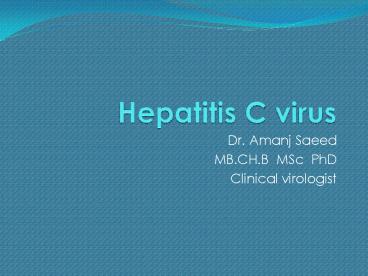Hepatitis C virus - PowerPoint PPT Presentation
Title: Hepatitis C virus
1
Hepatitis C virus
- Dr. Amanj Saeed
- MB.CH.B MSc PhD
- Clinical virologist
2
Hepatitis C Virus (HCV)
Envelope
- HCV is small enveloped positive sense RNA virus
- Belongs to Genus Hepacivirus of Flaviviridae
family - Genome is 9.6 kb.
- 6 major genotypes.
Core
Envelope Glycoproteins
Viral RNA (9400 nucleotides)
3
HCV
- Hepatitis C virus (HCV) is a small, enveloped
positive strand RNA virus belong to a genus
Hepacivirus of the Flaviviridae family - An estimated 200?? million people worldwide are
infected with HCV . - 80 of infected individuals will develop chronic
persistent infection, and of these 30 will
develop progressive liver diseases including
chronic hepatitis, cirrhosis and hepatocellular
carcinoma (HCC).
4
HCV
- HCV infection has a major impact on public
health, yet no vaccine is available to prevent
the infection and the antiviral therapies are
characterised by - limited efficacy
- high cost
- substantial side effects.
5
STRUCTURAL GENES
NON-STRUCTURAL GENES
ve ss RNA Genomic
organisation
FLAVIVIRUS
6
HCV receptor interaction
- E1 and E2 are essential for host cell entry by
binding to receptors and inducing fusion of the
host cell membrane - Several cell surface molecules have been proposed
to play a role in mediating HCV attachment and
entry - the tetraspanin CD81
- scavenger receptor class B type 1 (SRB1)
- heparin sulphate (HS)
- and the low density lipoprotein (LDL) receptor,
claudin-1 and occludin. - Epidermal growth factor Receptor
- Ephrin receotor
7
Translation of HCV genome
- Translation of HCV genome yields a polyprotein
precursor that is subsequently processed by
cellular and viral proteases. - Structural proteins include (core, E1, E2, P7)
- Nonstructural proteins include NS2, NS3, NS4A,
NS4B, NS5A, NS5B.
8
HCV replication
- HCV Replication proceeds via formation of
complementary minus strand RNA using a viral
genome as a template and subsequent synthesis of
plus strand - Both these steps are dependent on NS5B (viral RNA
Dependent RNA polymerase).
9
HCV
- HCV genome replication is associated with a high
mutation rate and sequence diversity which
eventually results in a circulating population of
diverse but closely related HCV variants, known
as a quasispecies which underlies the following - capacity to escape against immune responses
- presence of multiple variants which facilitate
the selection of adaptive mutations.
10
HCV genetic diversity consequences
- Diagnosis
- may result in false negativity
- Pathogenicity
- are all genotypes equally dangerous?
- Treatment
- do all genotypes respond equally to therapy?
- Vaccine development
- creates problems
11
Models for studying HCV pathogenesis
- Analyzing the effect of HCV on transformed cell
lines. - transgenic technology.
- Infection with related viruses (like GBV-B)
- The best model for HCV study is using chimpanzees
(economic and moral reasons limit the use of
chimpanzee in research).
12
Models for studying HCV pathogenesis
- Sub-genomic replicon systems .
- generation of an infectious clone of a genotype 2
isolate of HCV known as JFH-1 which has the
capacity to go through a full viral life cycle
and produce infectious virus in hepatocyte
derived cell lines.
13
Models for studying HCV pathogenesis
- HCV pseudoparticles (HCVpp).
- Recent studies developed an experimental system
to use primary human hepatocytes as a model for
studying HCV pathogenesis
14
Anti-HCV POSITIVE
- Evidence of infection at some time
- Gives no indication as to when infection occurred
- Gives no indication as to whether infection was
cleared or is still present
15
Anti-HCV Negative
- No evidence of infection with HCV
- BUT - be aware of possible false negatives
- if infection very recent (window period)
- if patient immunosuppressed at time of infection
16
Genome Detection
- Requires amplification eg Reverse Transcriptase
Polymerase Chain Reaction - Technically more exacting
- Expensive
17
Interpretation RT/PCR results
- POSITIVE
- infectious
- at risk of chronic liver disease
- requires liver biopsy
- NEGATIVE
- not infectious
- not at risk of chonic liver disease
- may not require biopsy
18
Hepatitis C virus routes of transmission
- Parenteral
- Injecting drug use
- Blood/blood products
- Other needles
- Failure of infection control eg outbreaks (see
refs) - Mother-to-baby (5)
- Sexual (?real)
19
CLINICAL OUTCOMES OF HCV INFECTION
ACUTE INFECTION Usually asymptomatic
Infection Resolved 15-25
CHRONIC INFECTION 75-85
ASYMPTOMATIC, mild liver disease
20 yrs
CHRONIC INFLAMMATORY HEPATITUS
CIRRHOSIS eg 20
5 yrs
HEPATOCELLULAR CARCINOMA
20
Mechanism of hepatic fibrogenesis in HCV infected
patient
Chronic inflammation and the wound healing
response are likely to be the framework within
which HCV induces hepatic fibrosis
21
Hepatitis C
Natural history of Hepatitis C Infection
Infection by Hepatitis C Virus
Acute Hepatitis (gt90 Asymptomatic)
6 Months
Chronic hepatitis (75-85)
Spontaneous recovery (15-25)
Chronic active (20)
Asymptomatic (80)
10-30 Years
Treatment
Cirrhosis (20)
Transplantation
HCC
22
HCV Natural History
Infection
23
Prevention of patient-to-patient HCV transmission
- screening
Blood donors anti-HCV Organ and tissue donors
anti-HCV Renal units regular anti-HCV
testing Antenatal screening NOT currently
recommended
24
Needlestick transmission of blood-borne hepatitis
viruses
25
Surgeon-to-patient HCV transmission phylogenetic
evidence
26
HCW-to-patient transmission of HCV UK data
Known transmissions from 5 surgeons (1 cardiac, 2
general, 2 OG) thus far
27
Protection of patientsGuidelines??
- Known HCV RNA ve HCWs OUT
- Current HCWs doing EPPs encouraged to be tested
if risk factors . - Needlestick injuries early Rx benefit to HCW
- For HCWs entering EPP-specialties test for HCV
infection
28
Diagnosis
- Test for viral antigen and Antibody (ELISA)
- Test for genome (Quantitative RNA PCR)
29
Treatment
- Pegylated INF-a Ribavirin































